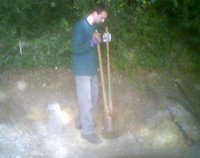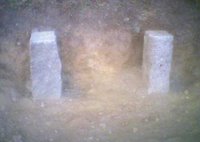Gate Widening near Chyvarloe
If a job's worth doing - it's worth doing well....
The Problem: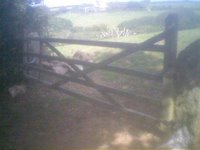
A tenant farmer on the Gunwalloe/Chyvarloe Estate needed to access a field with a tractor in order to flail the hedges in the field margins. The gates were too small to allow him access as they had been built over 100 years ago. The gate posts were made of quarried granite which is in the traditional Cornish style.
The Solution:
Firstly, blackthorn scrub was cleared from the gateway with a brushcutter and a small section of Cornish hedge adjacent to the granite gate post to be moved was dismantled. The gatepost was dug out with a digging bar and then lifted with a strop attached to the front-loader of a tractor. The old hole was filled in and the soil compacted before measuring out the required gateway width and relocating the hole with a line in order to ensure the correct alignment of the gate relative to the track.
The granite was placed into the new post hole with the tractor once it had been checked for the correct depth. It was guided into position using line and a bubble level to make sure that it was vertical and that its face was aligned with that of its counterpart. Rock and soil was compacted around the post with a digging bar to hold it in position as the hole was filled equally and gradually.
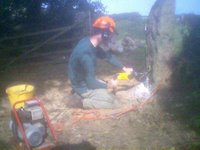 Once the post was securely in place, the gate was resized to the required width by extending the rails with mortice and tenon jointing. Hinge pins then needed to be located on the posts by holding the gate against the posts. The holes were then drilled with a DeWalt industrial hammer drill run off a generator to provide the required power to hammer through granite. The hinge pins were knocked into place and secured with epoxy resin.
Once the post was securely in place, the gate was resized to the required width by extending the rails with mortice and tenon jointing. Hinge pins then needed to be located on the posts by holding the gate against the posts. The holes were then drilled with a DeWalt industrial hammer drill run off a generator to provide the required power to hammer through granite. The hinge pins were knocked into place and secured with epoxy resin.
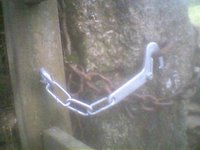 The gate was secured to the post with a locked chain and the latch was was secured to the gate with a fencing staple to deter theft of vandalism.
The gate was secured to the post with a locked chain and the latch was was secured to the gate with a fencing staple to deter theft of vandalism.
The adjacent section of Cornish hedge was restored and a small section of post and rail was installed to make it stock proof.
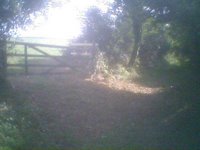 The gate now opens onto the track, blocking the thoroughfare when fully open and can remain in this position. This is useful for herding cattle into the field when coming up the track.
The gate now opens onto the track, blocking the thoroughfare when fully open and can remain in this position. This is useful for herding cattle into the field when coming up the track.
The Problem:

A tenant farmer on the Gunwalloe/Chyvarloe Estate needed to access a field with a tractor in order to flail the hedges in the field margins. The gates were too small to allow him access as they had been built over 100 years ago. The gate posts were made of quarried granite which is in the traditional Cornish style.
The Solution:
Firstly, blackthorn scrub was cleared from the gateway with a brushcutter and a small section of Cornish hedge adjacent to the granite gate post to be moved was dismantled. The gatepost was dug out with a digging bar and then lifted with a strop attached to the front-loader of a tractor. The old hole was filled in and the soil compacted before measuring out the required gateway width and relocating the hole with a line in order to ensure the correct alignment of the gate relative to the track.
The granite was placed into the new post hole with the tractor once it had been checked for the correct depth. It was guided into position using line and a bubble level to make sure that it was vertical and that its face was aligned with that of its counterpart. Rock and soil was compacted around the post with a digging bar to hold it in position as the hole was filled equally and gradually.
 Once the post was securely in place, the gate was resized to the required width by extending the rails with mortice and tenon jointing. Hinge pins then needed to be located on the posts by holding the gate against the posts. The holes were then drilled with a DeWalt industrial hammer drill run off a generator to provide the required power to hammer through granite. The hinge pins were knocked into place and secured with epoxy resin.
Once the post was securely in place, the gate was resized to the required width by extending the rails with mortice and tenon jointing. Hinge pins then needed to be located on the posts by holding the gate against the posts. The holes were then drilled with a DeWalt industrial hammer drill run off a generator to provide the required power to hammer through granite. The hinge pins were knocked into place and secured with epoxy resin. The gate was secured to the post with a locked chain and the latch was was secured to the gate with a fencing staple to deter theft of vandalism.
The gate was secured to the post with a locked chain and the latch was was secured to the gate with a fencing staple to deter theft of vandalism.The adjacent section of Cornish hedge was restored and a small section of post and rail was installed to make it stock proof.
 The gate now opens onto the track, blocking the thoroughfare when fully open and can remain in this position. This is useful for herding cattle into the field when coming up the track.
The gate now opens onto the track, blocking the thoroughfare when fully open and can remain in this position. This is useful for herding cattle into the field when coming up the track.
